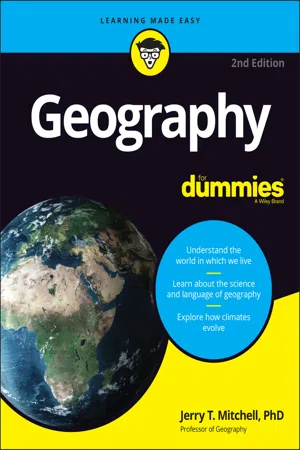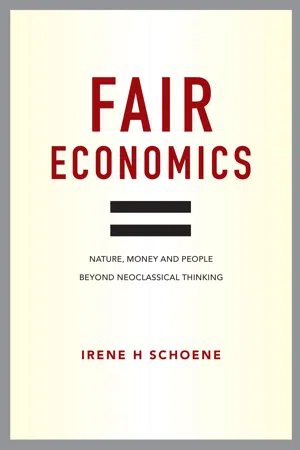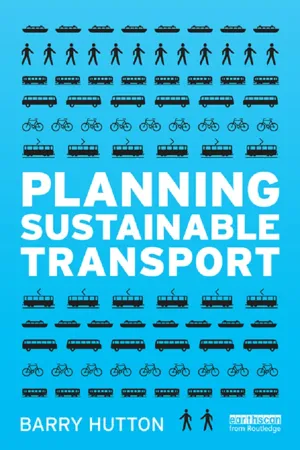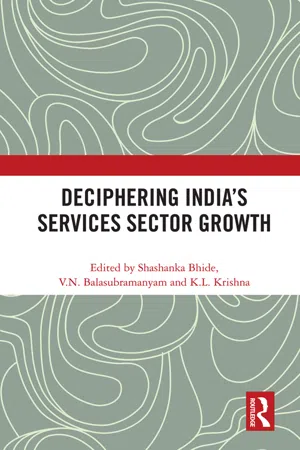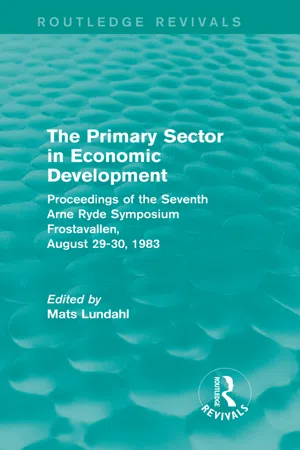Geography
Secondary Sector
The secondary sector refers to the part of the economy that transforms raw materials into finished goods through manufacturing and construction activities. This sector involves the processing and assembly of raw materials into products such as automobiles, electronics, and machinery. It plays a crucial role in adding value to raw materials and creating tangible goods for consumption and use.
Written by Perlego with AI-assistance
Related key terms
Related key terms
1 of 4
Related key terms
1 of 3
6 Key excerpts on "Secondary Sector"
- eBook - ePub
- Alasdair Blair, David Hitchcock(Authors)
- 2004(Publication Date)
- Routledge(Publisher)
7: Secondary industries: adding value and carrying the burden
- What are the secondary industries?
- Bringing the resources together
- Manufacturing processes
- Environmental implications of products after manufacture
- Business practices
- Some characteristics of the construction industry
- The construction cycle
The key conceptual shift manufacturers need to make in becoming more sustainable is to see themselves as selling services rather than goods. (Roodman, 1999)The secondary industries can be thought of as the manufacturing sector, the area of the economy that many regard as ‘industry’. These are the industries discussed in the majority of the literature when they talk of the environmental impacts of industry. This is not surprising since this is the sector from which much of the pollution and waste products emanate. It is also the area that many of the world’s largest companies operate in and results in the production of all the world’s tangible products—everything from oil tankers to microprocessors and from beer to heavy chemicals.What are the secondary industries?
Manufacturing is the core of the secondary industries. Raw materials and components are brought together and manufactured into either an end product or a component for some other manufacturing process. In economic terms resources are transformed giving value added. So, for example, when a ton of potatoes are manufactured into a ton of potato crisps the value of the potato rises from somewhere between £70 and £120 for the potatoes at the farm gate to about £10,000 for the crisps on the supermarket shelf. An essential feature of these industries is that some tangible product results at the end of the process.There are a wide range of processes encompassed within the secondary industries which makes generalizations difficult. However, many of the environmental concerns surround heavy industry and those industries handling particularly hazardous, toxic or environmentally sensitive material. It is this area on which most of the literature has concentrated. Environmental groups for just these reasons have singled out the heavy chemical industry, pesticide and food processing industries for criticism. The chemical industry, oil refining and metal smelting, including the iron and steel industry, are all associated with significant amounts of waste products and pollution. All are also major users of energy. Other manufacturing industries that have close links to biological processes, such as pesticides, also affect the environment. In addition, food manufacture, the textile industry and leather tanning all have the potential to create considerable pollution of the environment. The disposal of organic wastes from these processes inevitably causes considerable disruption to ecosystems. A further industry where pollution is potentially a major problem is paper and pulp manufacture. Mills require considerable quantities of clean water but often result in the widespread pollution of rivers downstream. The secondary industries also include less controversial areas and areas which are often considered outside manufacturing per se - eBook - ePub
- Jerry T. Mitchell(Author)
- 2022(Publication Date)
- For Dummies(Publisher)
Primary activities are resource-oriented and extraction intensive. In each case, the relationship with the environment is intimate and location-specific — meaning that you can’t grow bananas, catch tuna, or mine coal just anywhere. Instead, you can only extract resources where they occur or, in the case of agriculture, grow particular crops where conditions are right. As a result, location options for many primary activities are limited.(© John / Adobe Stock)FIGURE 15-1: This open pit gold mine in Australia is an example of primary economic activity.Secondary activities
Secondary activities change the form of raw materials in ways that add to their value. Examples include processing and manufacturing. Thus, a cheese maker may transform milk into cheddar, which also has a different form and higher price than its raw material. Similarly, an automobile manufacturer might bring together headlights, tires, upholstery, spark plugs, and so forth at an assembly plant and transform them into a vehicle that has a different form and higher cost than the sum of its parts.As these examples illustrate, the raw material required by a secondary activity could be either a natural substance (milk) or products of previous processing or manufacturing (tires). Those secondary activities that require natural raw materials usually are located close to relevant primary activities in order to minimize transportation costs. In contrast, those secondary activities that require processed or manufactured raw materials are less intimately tied to the natural environment and have more location options.Tertiary activities
Tertiary activities - eBook - ePub
Fair Economics
Nature, money and people beyond neoclassical thinking
- Irene Schoene(Author)
- 2015(Publication Date)
- Green Books(Publisher)
Contrary to the dependency on nature we have outlined for goods in the primary sector, industrial material goods can be produced at anytime, in any quantity and in any place. From the viewing point of this sector, human dependency on nature – so typical of the primary sector – is indirect. The Secondary Sector of the economy includes all production of such commercialized merchandize. The matter of what, where and in what quantity this type of merchandize is produced seems to have become the quasi-autonomous decision of the producer. The entrepreneur has positioned himself in total control of the production process. He creates the vision for new technologies and new products. And therefore he is the one who decides how the future of society will be shaped – according to the commodities he brings to the market’. The ‘raw’ materials for his products can be bought from anywhere and shipped to any location for final production. Any industrially-manufactured article looks identical to the other. Industrial products as well as industrialized production can be standardized. On a highly technical level, the goods can be produced by machines, almost without human involvement. The manufactured merchandize is often called ’ ‘white’ and ‘brown’, and labourers who still produce them are ‘blue collar’ workers.Goods from the Secondary Sector can be produced and stored independently of season and well ahead of their sale with virtually no loss of quality and profit, which was a problem with primary sector goods. They can be transported to any location where the conditions of sale seem favourable. Transportation time is no longer so important. The only limiting factor is the cost.Advertising can now show an article, which, when paid for, will change from being owned by its producer to being owned – and hence totally controlled – by the consumer. Advertising is used to arouse consumers’ interest in buying an article. Their involvement in the economic process is limited to a choice of ready-made products.The more that is produced and sold, the more profit can be made. Profit can always increase, and this is the aim of the producer. How much money is made seems to be up to human industriousness alone. The more one works, the more money one can make. The lifetime of products is even perhaps artificially shortened, as only through the sale of new wares can new profits be realized. While food consumption is limited to peoples’ natural needs, money does not succumb to that law. It has no limits. It can become infinite, as Thomas Aquinas (1225–1274) was already aware in the 13th - eBook - ePub
- Barry Hutton(Author)
- 2013(Publication Date)
- Routledge(Publisher)
Much of the history of civilisation has been focused upon making movement easier by building and using the means of carrying things; first the tracks along which movement could take place, then the vehicles to move along the tracks, then the energy to power that movement, and then systems of control and organisation of the movement. The transport system cannot be ubiquitous; it has to link selected places. Some activities are tied to particular places: coal cannot be mined wherever the mood takes people, crops cannot be grown on rocky, mountainous slopes. Most of primary industry (the gathering of basic raw materials, farming and fishing) is geographically fixed and must be served initially by simple, dedicated routes. Secondary industry (production fed with raw materials) and tertiary industry (processing information) is not tied to precise locations and may be located wherever the inputs can be amassed to best advantage. The extra movement then attracts the development of the network to better serve the needs of the activity.The dynamic picture is of a civilisation with constantly growing primary and secondary industry linked together by an ever-more complex, efficient transport network. This was initially composed of no more than a disjointed pattern of simple routes serving primary production, but it developed slowly through the construction of ports and roads followed by investments in ever-new transport technologies, until today the global movement of people, freight, energy, information and waste pulses through a transport fabric of interwoven real and virtual threads. Primary, secondary and tertiary industry throughout the world is served by an infrastructure of roads, ports, sea- and airways, pipes and wires all thrumming with movement.Over most of history the drive to develop the transport system was to provide better and cheaper movement for existing traffic: if that then stimulated new activity then so much the better, but that was not the immediate objective. From Roman ports and roads, through the turnpike, canal, railway and motorway ages, the basic motive was to carry existing movement more efficiently. Of course, the improvements to the transport network did change the economic geography, but that was incidental, not the basic purpose. The British motorway system, like the investment in railways a century before, was a remedial policy correcting the inadequacies of the road network. However, both the railways and the motorways changed the absolute and relative patterns of accessibility and so changed the geography of development. A good example is the concentration of warehousing and distribution depots in the vicinity of Junction 18 on the M1, all built on land which would have remained as farmland had it not been for the proximity of the motorway. Such development was not a reason for the construction of the motorway but became an unintended, if nonetheless welcome, result. - eBook - ePub
- Shashanka Bhide, V.N. Balasubramanyam, K.L. Krishna, Shashanka Bhide, V.N. Balasubramanyam, K.L. Krishna(Authors)
- 2020(Publication Date)
- Routledge India(Publisher)
The term services sector refers to, at the most aggregate level, a large group of activities that include trade, hospitality (hotels, restaurants), transportation, communication, entertainment, health, education, and public services. It can be argued that, even at the aggregate level, the services sector is more heterogeneous than the other two sectors, agriculture (primary sector) and industry (Secondary Sector). Thus, if the primary sector involves producing goods directly from natural resources (agriculture, fishing, hunting, mining, and so on) and the Secondary Sector involves modifying material goods into other more useful products and commodities, then the tertiary or the services sector includes all activities that do not produce or modify material goods (Illeris, 2007). In other words, unlike the output of agriculture, mining or manufacturing which are material and tangible, the output of the services sector such as teaching, cleaning, selling, curing and entertaining have no physical form and therefore are immaterial or intangible (Noon, 2003).Given its nature and heterogeneity, there is a large body of literature in which scholars have debated on the precise definition and identification of the services sector.2 In this debate, scholars have argued that even in the most advanced countries where the services sector accounts for the largest proportion of all economic activities, it is defined negatively or as a residual comprising all economic activities that do not belong either to the primary or Secondary Sector (Illeris, 2007).T.P. Hill wrote a set of influential papers on the concept and definition of the services sector as being distinct from goods (Hill, 1977; 1979). In an early review on what constitutes the production of goods and what would be services, Hill (1977) provides a positive definition of the services sector ‘as a change in the condition of a person, or of a good belonging to some economic unit, which is brought about as the result of the activity of some other economic unit, with the prior agreement of the former person or economic unit’.3 Despite its ‘vagueness’ in part, the positive definition by Hill was nevertheless influential and contributed to the UN System of National Accounts (Illeris, 2007). The internationally accepted definition of what constitutes services is given by the UN SNA (1993) as follows: ‘Services are not separate entities over which ownership rights can be established. They cannot be traded separately from their production. Services are heterogeneous outputs produced to order and typically consist of changes in the conditions of the consuming units realised by the activities of producers at the demand of the consumers’. By the time their production is completed they must have been provided to the consumers.4 And the production of services must be confined to activities that are capable of being carried out by one unit for the benefit of another. Otherwise, service industries could not develop and there could be no markets for services. It is also possible for a unit to produce a service for its own consumption provided that the type of activity is such that it could have been carried out by another unit.5 - eBook - ePub
The Primary Sector in Economic Development (Routledge Revivals)
Proceedings of the Seventh Arne Ryde Symposium, Frostavallen, August 29-30 1983
- Mats Lundahl(Author)
- 2015(Publication Date)
- Routledge(Publisher)
1. The Primary Sector and Production
The Four Concepts of the Primary Sector
What the primary sector is, what its functions and composition are, is far from clear. There can be at least four concepts or definitions of the primary sector. According to the first, ‘narrow’ definition, primary is synonymous with agriculture. The function of the primary sector is to produce agricultural consumer goods. In terms of the second ‘intermediate’ definition, the primary sector includes all activities needed to produce and deliver agricultural goods to the final consumer. The primary sector consists both of goods and services production. Storage, transportation, trade and even those personal services transforming the quantity, time and location dimension of agricultural goods6 are an integral part of it. The second is basically the definition used by Colin Clark.7The third notion of the ‘extended primary sector’ includes all rural activities producing agricultural, service and industrial consumer goods needed for the survival of a family. The function of the extended primary sector is to produce all consumer goods needed by rural households. As long as they are consumer-oriented and rural, all agricultural, service and industrial activities are part of it.And then there is the fourth and ‘broadest’ notion which includes within the primary sector all consumer and capital goods produced by and needed for the survival of rural families. Primary now is synonymous with rural. The primary is a multifunctional, multi-activity, multi-product and multi-service sector.The Four Types of Primary Sector Labour Surplus
This fourfold classification of the primary sector is the first step in the process of decomposing its structure, identifying its idiosyncratic features and developing novel development strategies. The usefulness of this classification can be seen by examining the four ‘labour surplus’ concepts that correspond to the four aforementioned notions of the primary sector. There exists, first, the well-known and celebrated notion of the ‘agricultural labour surplus’.8 Surplus agricultural labour (narrow primary-sector labour surplus) is that part of the rural labour force that cannot
Index pages curate the most relevant extracts from our library of academic textbooks. They’ve been created using an in-house natural language model (NLM), each adding context and meaning to key research topics.
Explore more topic indexes
Explore more topic indexes
1 of 6
Explore more topic indexes
1 of 4

